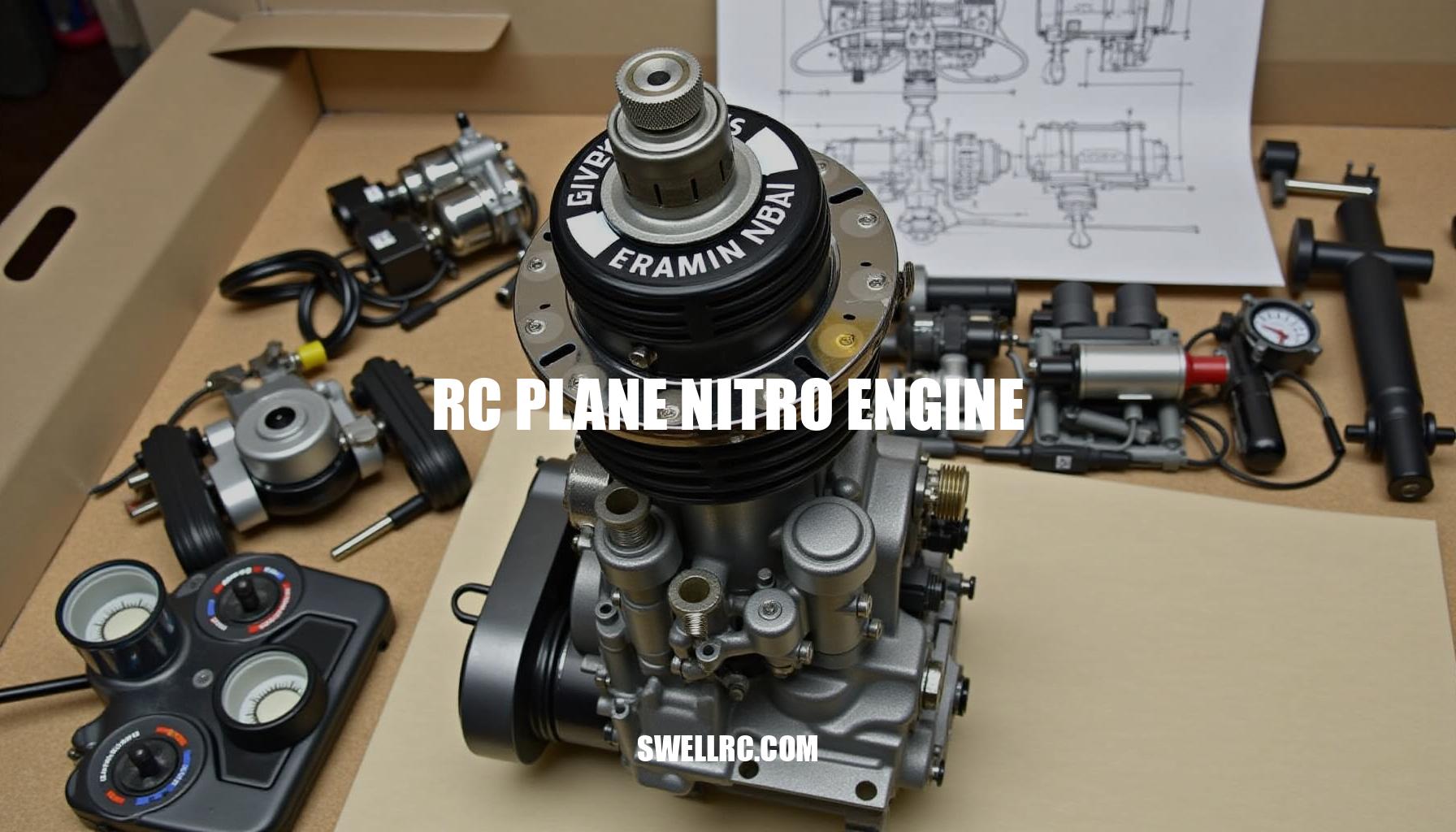RC Plane Nitro Engine Tuning Guide
The world of RC model airplane engines offers enthusiasts a captivating choice of power systems, with RC nitro engines standing out for their unique blend of performance and character. Nitro engines, sometimes called glow engines, run on a specialized model airplane fuel composed of methanol, nitromethane, and lubricating oil, delivering an authentic throttle response and that signature glow crackle sound cherished by many. When weighing nitro vs gas vs electric powerplants, nitro engines excel in power-to-weight ratio, making them ideal for flyers seeking both responsiveness and realism.
While gasoline engines provide strong power for larger models and electric setups offer simple operation with instant torque, nitro engines strike a balance with moderate operating costs and a hands-on tuning experience involving carburetor needles. Proper engine maintenance for RC models powered by nitro fuels includes routine cleaning and oiling to ensure consistent performance and longevity. Whether you’re a seasoned pilot or new to the hobby, understanding these aspects will help you select the right RC nitro engine and keep it finely tuned so your airplane sings each time you throttle up.
Understanding the Mechanics — Deep Dive into Nitro Engine Functionality
At heart, a nitro engine is a tiny, elegant internal combustion machine designed for optimal performance in RC models. The process begins as air and atomized fuel mix precisely in the carburetor, which requires careful carburetor adjustment using high-speed and low-speed needles to maintain the ideal fuel-air ratio. This finely tuned mixture is pulled into the crankcase before being transferred to the cylinder where the piston and liner (commonly configured as ABC/ABN) compress the charge.
Ignition is catalyzed by a heated glow plug, often incorporating platinum elements that enable reliable combustion of methanol-based fuel. The compression ratio within the cylinder is critical for engine efficiency, influencing power output and responsiveness. As the fuel ignites, expanding gases drive the crankshaft, converting chemical energy into mechanical motion.
Exhaust gases are expelled efficiently through scavenging, a process enhanced by a tuned pipe or muffler that not only helps clear spent combustion gases but also improves torque and throttle response.
| Characteristic | 2-Stroke RC Engines | 4-Stroke RC Engines |
|---|---|---|
| Reliability | Excellent when tuned precisely | More tolerant at mid-throttle, slightly more complex |
| Sound | Higher-pitched crackle | Throaty, scale-like exhaust note |
| Torque | Peaky power delivery | Strong low to mid-range torque |
| Fuel Consumption | Higher consumption for comparable output | More economical under similar conditions |
| Weight and Complexity | Lighter and simpler design | Heavier and more mechanically complex |
For enthusiasts seeking dependable, parts-supported powerplants, trusted brands such as OS model airplane engines are a popular choice. They offer great support and reliability, enhancing the flying experience. To dive deeper into 2-stroke vs 4-stroke RC engines nuances and the valvetrain intricacies of 4-stroke models, exploring dedicated resources is highly recommended.
Choosing the Right Nitro Engine — Matching Engine Power to Flight Ambition
When selecting an engine for your RC airplane, it’s essential to consider more than just engine displacement. Evaluating the power-to-weight ratio and propeller compatibility ensures optimal performance tailored to your airframe’s needs. Typically, common nitro engine sizes are matched to various plane categories as follows:
- .15–.25 2-stroke: Ideal for 0.9–1.5 m wingspan trainers and light sport models.
These engines pair well with props approximately 8×4 to 9×5, delivering efficient thrust for smaller planes.
- .46–.55 2-stroke: Suited for classic .40-size trainers, sport, and aerobatic planes. Propellers in the 10×6 to 11×6 range complement these engines, balancing speed and torque.
- .61–.72 2-stroke: Perfect for mid-size aerobatic and warbird models. Props around 11×7 to 12×6 provide the necessary thrust for agile maneuvers.
- .70–.91 4-stroke: Designed for scale birds or STOL aircraft where torque and authentic engine sound are priorities.
Recommended props range from 12×6 to 13×8.
- 1.00–1.20 4-stroke: Best for heavier, large-scale models and towing applications, utilizing props roughly 13×8 to 15×6 to maximize thrust.
Understanding the distinction between torque vs RPM is crucial: bigger props demand higher torque, common in 4-strokes, while smaller, high-pitch props suit revvy 2-stroke engines. Aim for a thrust-to-weight ratio of at least 0.7:1 for trainers to ensure stable flight, and between 1.0–1.3:1 for spirited sport or aerobatic planes for responsive control.
Nitro engines excel in medium-size airframes desiring crisp throttle response and authentic sound; however, for larger, heavier models—often found in giant scale—RC airplane gas engines become more compelling due to their fuel efficiency and torque advantages. For detailed comparisons, check out comprehensive overviews on RC airplane gas engines and category-specific analyses at model airplane gas engines.
As a rule of thumb, always select the smallest engine that fulfills your thrust requirements using a propeller that the airframe can clear comfortably and that the structure can handle safely.
Matching these factors — power-to-weight ratio, prop load, and thrust-to-weight — ensures balanced performance whether you’re flying aerobatic or scale planes.
Setup & Tuning — Getting Your Nitro Engine to Sing
There’s nothing like the moment a freshly broken-in engine settles into a crisp, smoke-kissed idle. Here’s the process I use for engine break-in and how to tune a nitro RC engine for peak performance and reliability.
What you need:
- Fresh fuel with appropriate nitro fuel mix ratio (commonly 5–15% nitromethane for sport planes, 18–20% total oil content)
- The correct glow plug types heat range
- Glow igniter or panel
- Electric starter or chicken stick
- Fuel pump and filters
- Screwdrivers/hex drivers
- Tachometer
- Temperature gauge
- After-run oil
Break-in (bench or securely mounted on the model):
- Set both needles to factory baseline (e.g., 2–3 turns open on high-speed; low-speed just flush with the throttle arm slot—consult your manual)
- Start rich and heat-cycle: perform 3–5 short runs, keeping temps in a safe band, and gradually lean a notch each tank while avoiding sustained high RPM early on
- Vary the throttle; don’t baby it cold, but don’t over-lean—aim for a wet, protective tune during break-in
Fuel prep and plumbing:
- Use a filter between the tank and carburetor; check that the clunk moves freely
- Ensure airtight fuel lines and connect the muffler pressure line
- Center the fuel tank near carb height to maintain consistent fuel flow
Initial tuning workflow (adapted from car-engine tuning principles such as those found at this guide):
- High-speed needle valve adjustment: start rich; perform full throttle passes; lean 1/12–1/8 turn at a time until peak RPM, then richen slightly for a cool, reliable margin
- Low-speed (idle/transition) tuning: from a reliable high-speed tune, perform the pinch test at idle—if the engine speeds up and dies in 2–3 seconds, you’re close; quicker signals lean, slower signals rich; adjust 1/16 turns accordingly
- Idle stop screw: set to achieve a steady idle with a clean transition
Troubleshooting nitro engine quick hits:
- Stalls on throttle-up: often a lean low-speed setting or too-low idle; verify there are no air leaks
- Overheating: usually caused by too lean a mixture, inadequate airflow, or too small a prop load; richen the needle setting and reassess the prop size
- Plug fouling: may result from an overly rich tune or old fuel; replace the glow plug and refresh with new fuel
- Hard starting: could be due to weak glow plug, flooded crankcase, or bad fuel; check glow strength and clear any floods
In a pinch, creative ignition and starting techniques are available, such as starting without a glow plug or without a dedicated igniter. Use these methods with proper safety precautions.
Consistency checklist for optimal tuning results:
- Always use fresh, filtered fuel and maintain sealed fuel lines with a healthy glow plug
- High-speed needle valve adjustment tuned just rich of peak RPM
- Low-speed needle set accurately via pinch test
- Confirm visible smoke trail under load; monitor engine temperatures; keep a log of needle settings after each session
Maintenance & Longevity — Keeping Your Nitro Engine in Peak Shape
A little routine care can significantly enhance nitro engine longevity, making your engine feel new for years. Proper engine maintenance for RC models involves consistent cleaning, inspection, and storage to prevent common issues like bearing noise and compression loss. Here’s a comprehensive overview of the maintenance schedule and tips to improve performance and durability:
| Maintenance Interval | Tasks |
|---|---|
| After Every Flight Day |
|
| Every 10–15 Flights |
|
| Seasonal / Long-Term Storage |
|
Cleaning methods are crucial for protecting engine components. Use denatured alcohol or specialized nitro cleaners to remove fuel residue, but avoid aggressive solvents that can degrade o-rings. Employ soft brushes and microfiber cloths to protect anodized parts from scratches, and always re-oil parts after deep cleaning sessions.
Following proper storage tips is vital because raw methanol-based fuel left inside the engine attracts moisture, promoting rust and bearing corrosion. For long-term storage, fogging the engine with after-run oil and sealing it in a plastic bag limits humidity exposure and maintains engine health.
Common wear issues such as bearing noise and compression loss can be mitigated by timely inspection and replacement. If bearings feel rough, consider upgrading to stainless steel or ceramic versions, especially if operating in damp climates. For compression loss, check for liner wear, piston ring damage (notably on 4-stroke engines), or problems with head shims.
Also, verify the carburetor o-rings to prevent vacuum leaks.
Fuel foaming or lean running can be managed by adding soft padding to the fuel tank, checking propeller balance, and ensuring muffler pressure integrity to maintain smooth engine operation.
By adhering to this structured maintenance routine and embracing proper engine maintenance for RC models, including the use of quality after-run oil and approved cleaning products, you can enjoy remarkable durability and top performance from your premium RC nitro engines for years to come.
Advanced Performance Tweaks — Beyond the Basics
When chasing that last 5% of performance in high-performance tuning, the details truly compound. Optimizing airflow and exhaust is critical: match the carb venturi precisely to your target RPM range to avoid over-choking or over-boring, and use a tuned pipe or muffler while adjusting header length to effectively shift the powerband. Ensuring an airtight backplate and carb is crucial, as eliminating reed or transfer leaks in specific engine designs prevents power loss.
Fuel blends play an equally vital role.
The nitro percentage raises cylinder pressure and throttle response; typical sport setups operate around 5–15% nitro, while high-performance builds push 20–30%. When pushing these limits, adding head shims can mitigate detonation or overheating. Maintaining total oil content near 18–20% for sport applications, incorporating castor oil for high-heat protection or opting for quality synthetics with strict temperature discipline, ensures reliability.
In hardware and balance, precise prop and spinner balancing is essential—vibration management avoids bearing damage and power loss.
Investing in high-quality or ceramic bearings and maintaining proper prop load safeguards temperature stability and long-term durability.
Competition tiers like RC F1 Nitro exemplify how meticulous tuning and exhaust upgrades push performance boundaries. For expert-level, high-RPM stability consider these pro tips:
- Tune on the prop you fly; aim for 200–300 RPM rich of peak.
- Track density altitude carefully and log needle valve settings with weather notes.
- Regularly pressure-test your fuel system every few sessions to avoid leaks or blockages.
- Refresh glow plugs proactively, sticking to one brand and heat range per setup.
- Re-check head bolt torque after initial heat cycles to maintain optimal compression.
Conclusion — Why Nitro Never Gets Old
From the needle-sharp throttle response to the unmistakable scent of hot castor oil carried on the breeze, nitro power keeps RC flying visceral and alive. Achieving optimal RC flight performance boils down to a few key elements that every enthusiast must master. First, engine selection is paramount — choosing an engine compatible with your airframe ensures balanced power and control.
Next comes a careful maintenance routine, starting with a patient break-in period to prolong engine life and reliability. Then, nitro engine tuning plays a critical role; tuning just rich of peak unlocks maximum performance while safeguarding your engine.
For hobbyists seeking to deepen their knowledge, this hobbyist guide covers everything you need to know about RC airplane engines, from practical advice to detailed category overviews. Numerous hours of testing reveal that first perfect engine start remains a magical moment, a testament to diligent care and expert tuning.
Explore more about selecting, tuning, and maintaining the perfect powerplant at the hub of RC airplane engines.
- Engine Selection: Match power to airframe size for optimal balance.
- Maintenance Routine: Regular lubrication, cleaning, and inspections keep engines running smoothly.
- Nitro Engine Tuning: Adjust needle valves to run slightly rich for safe, powerful operation.
- RC Flight Performance: Tuned engines provide crisp throttle response and sustained power.
Frequently Asked Questions
- What makes a nitro engine different from a gas or electric RC engine?
Nitro engines burn methanol-based fuel with nitromethane and oil, using a glow plug for ignition; they deliver lively throttle feel, authentic sound, and moderate maintenance. Gas engines use gasoline with spark ignition—great for larger models and lower fuel cost. Electric setups are quiet, simple, and powerful but lack the combustion character many pilots enjoy. - How do you properly break in a nitro engine for an RC plane?
Start with factory needle settings and a rich mixture, then run several short heat cycles while gradually leaning slightly each tank. Keep temperatures in a safe range, vary throttle, and avoid long high-RPM runs early. After 3–5 tanks, you can finalize tuning just rich of peak RPM for reliable flight. - What’s the best fuel mix ratio for nitro RC engines?
For most sport planes, 5–15% nitromethane with 18–20% total oil content works well. Higher nitro (20–30%) boosts torque and throttle response but may require extra head shims and careful temperature management. Always follow your engine manufacturer’s recommendations. - How can I tune my RC plane nitro engine for maximum performance?
Tune the high-speed needle at full throttle to peak RPM, then richen slightly for cooling and reliability. Set the low-speed needle using the pinch test for clean idle-to-full transition, and adjust idle stop for a steady tickover. Confirm a light smoke trail under load and verify temps with a tach and temp gauge. - Are 2-stroke or 4-stroke nitro engines better for RC planes?
Neither is universally better—2-strokes are lighter and revvier, ideal for aerobatics and sport. Four-strokes offer strong low–mid torque, great fuel economy, and a scale-like sound that suits warbirds and realistic models. Choose based on airframe goals and the prop size you want to swing. - How do I troubleshoot if my nitro engine won’t start?
Check glow plug health, fresh fuel, and airtight fuel lines; prime the carb and ensure muffler pressure is connected. If flooded, open throttle, remove glow plug, and clear fuel before retrying. Persistent issues often trace to air leaks or overly lean needle settings—back out the needles to a known baseline and try again. - How long does a nitro RC plane engine typically last?
With proper tuning, filtered fresh fuel, and after-run oil, a quality nitro engine can run reliably for many seasons—often hundreds of flights. Bearings and glow plugs are consumables; periodic replacements keep performance crisp. Abuse (over-lean runs, dirty fuel) shortens lifespan significantly. - What are the most reliable RC nitro engine brands?
Brands with strong reputations and parts support—like OS and several long-standing glow manufacturers—are favored by many pilots. Choose models with clear manuals, accessible spares, and proven track records in your airframe size. Local club experience and hobby shop advice are invaluable when selecting a brand and displacement.



